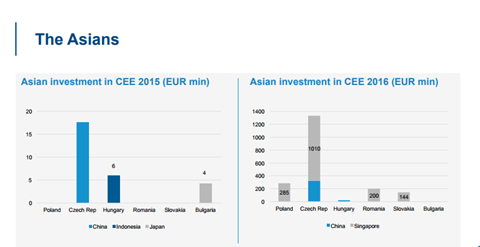New capital is flowing into Central and Eastern Europe from different parts of the world, as more foreign investors look for diversification and yield, delegates heard at the PropertyEU CEE Summit in Warsaw recently.

‘Investment flows are in a very healthy state,’ said Richard Divall, head of cross-border capital markets EMEA at Colliers International. ‘There is a wave of capital coming from different types of investors from new regions of the world, which is encouraging. Poland might reach the €5 bn mark this year.’
Capital flows to the region reached a cyclical high of €12.1 bn in 2016, reflecting a growing trend from €1.6 bn in the first quarter to €5.4 bn in the last three months of the year. The momentum is still there, as estimated flows in Q1 2017 were €2.8 bn, well ahead of the same period last year.
‘There is a changing of the guard,’ Divall said. ‘It used to be mainly German and UK institutional money coming to CEE, but now we see capital from the Middle East, South Africa and Asia.’
The figures show the extent of the change that is taking place. Between 2011 and 2016 the share of European investment has halved from 44% to 22%, while UK capital has shrunk from 18% to 7% and flows from the US have gone from 14% to 10%.
By contrast, CEE domestic investment has grown from 1% to 19% of the total, while South African capital, which only accounted for 2% in 2011, surged to 20% last year. Asian investment, which five years ago did not feature at all, is now at 16% and growing fast.
Asian money 'discovers' CEE
Asian capital, which until recently targeted mainly the UK and certain areas of Western Europe, is in the process of discovering CEE markets. In 2015, China invested a total of €18 mln in the Czech Republic. Last year, the figure rose to €323 mln. Singapore, which was nowhere to be seen in 2015, invested €144 mln in Slovakia last year, €200 mln in Romania, €285 mln in Poland and over €1 bn in the Czech Republic.
The figures are skewed by two big-ticket logistics deals – CIC’s acquisition of Logicor for €12.2 bn and GIC’s acquisition of P3 for €2.4 bn – but they show a clear direction of travel. All the six types of real estate investors are showing interest in the region: sovereign wealth funds, global insurance companies, private equity companies, family offices, global REITs and developers and global investment managers.
This last category is the one that matters the most when it comes to encouraging more Asian investment into CEE, Divall said: ‘Global investment managers are the guys who can get the new money into your markets because they have the local expertise. They play a crucial role because they understand the buying processes and the market dynamics.’
It is difficult to over-estimate the importance of groups like CBRE Global Investors, Hines, UBS, GLL, Patrizia or AEW Europe, Divall said. ‘GLL brought South Korean money, CBRE brought Malaysian money, AEW have mandates from Australia and Texas. The Asian capital that relies on local investment managers is already on its way to CEE, even if you may not be aware of it.’
Gateway cities
Asian investors tend to look at gateway cities first and an important thing for them is quality of infrastructure and transport links, Divall said: ‘Direct access by air is very important, because it puts your city and your country on the map. Manchester’s decision to start direct flights to Bejing paid off: within two months China had invested £800 mln into a business park near the airport.’
Other issues that foreign investors take into account are rule of law and tax transparency, finance costs and the strength of the local market. ‘Hungary and the Czech Republic have a lot of local institutions, which is encouraging to investors,’ said Divall. ‘If Poland goes down the REIT route, that would be a positive incentive.’
Last but not least, ‘political uncertainty is a big issue', he said. ‘It is what is deterring people from the UK now. The Czech Republic’s safe politics encourages investment, while Hungary is becoming more predictable so it will see more money coming in. Poland has a few political issues to solve, but maybe pricing is the biggest issue.’










